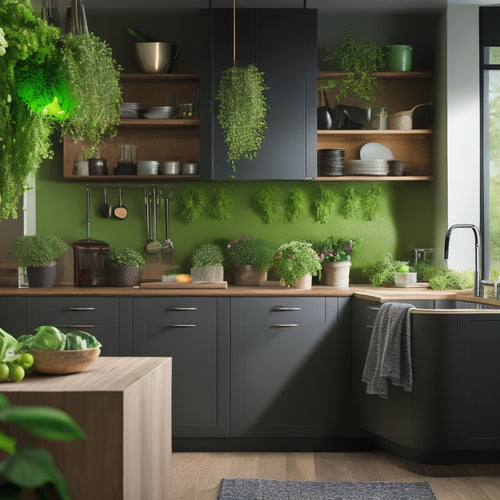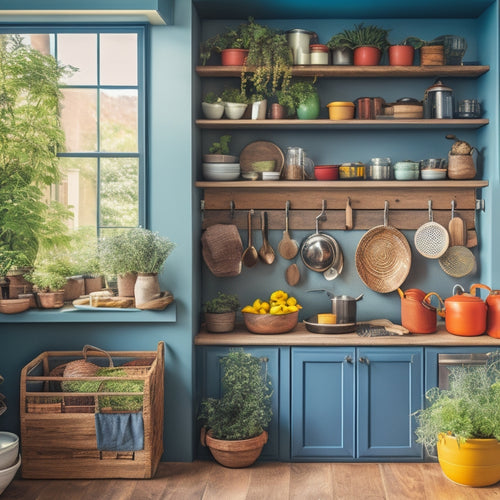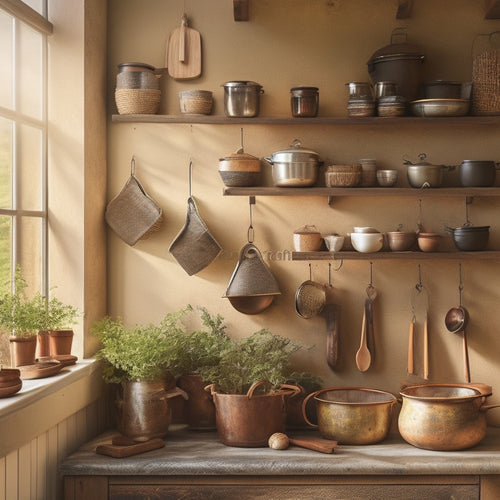
What's Holding You Back From a Clutter-Free Kitchen?
Share
You're likely struggling with a cluttered kitchen due to limited cabinet space, disorganized counters, inadequate pantry organization, insufficient drawer storage, and unutilized vertical space. You're not alone - many kitchens face these common obstacles. You might be storing too many items in cabinets, leaving countertops congested, or neglecting to categorize pantry items. Your drawers might be cluttered with duplicates, and you're not maximizing your kitchen's vertical space. Identifying these challenges is the first step towards a clutter-free kitchen. Now, take the next step to uncover simple solutions to overcome these hurdles and transform your kitchen into a stress-free haven.
Key Takeaways
• Limited cabinet space and inefficient storage solutions hinder a clutter-free kitchen.
• Disorganized kitchen counters and lack of designated zones for tasks lead to clutter accumulation.
• Inadequate pantry organization and failure to categorize items make it difficult to find what you need.
• Insufficient drawer storage and lack of dividers or organizers result in cluttered and hard-to-reach items.
• Unutilized vertical space and failure to maximize storage opportunities contribute to a cluttered kitchen.
Limited Cabinet Space
Since you're working with limited cabinet space, you need to prioritize what you store in them and where you store it. This means being intentional about the items you keep in your cabinets and finding creative solutions to maximize the space you have.
Consider installing kitchen shelving or adjustable shelves to make the most of your cabinet's vertical space. This will allow you to store less frequently used items, like special occasion dishes or cookbooks, while keeping everyday essentials within easy reach.
Another strategy is to categorize your kitchen items into zones, grouping similar items together, such as baking supplies or cooking utensils. This will help you identify what you need to store and what you can donate or discard.
Disorganized Kitchen Counters
With your cabinets organized, it's time to tackle the cluttered counters that are making meal prep and cooking a chaotic experience. Cluttered surfaces and messy shelves aren't only frustrating, but they also make it difficult to find what you need when you need it. Take a step back and assess your countertops. What's taking up valuable space? Are there appliances you rarely use or expired ingredients lingering?
Begin by clearing off everything and grouping similar items together. Designate a specific zone for each task, such as a baking station or coffee bar. Keep frequently used items within easy reach, and store less-used items in labeled bins or containers.
Inadequate Pantry Organization
Now that your countertops are clutter-free, turn your attention to the pantry, where expired or hard-to-reach items may be hiding, making meal planning and grocery shopping a challenge. It's time to tackle the pantry's disorganization and create a system that works for you.
To get started, take everything out of your pantry and sort items into categories (e.g., baking supplies, snacks, etc.). Then, assign a home for each category using pantry labels and container organization. This will help you see what you have and where it's stored.
Here's a simple framework to follow:
| Category | Container/Label |
| Baking Supplies | Large bin with label |
| Snacks | Small bins with labels |
| Canned Goods | Stackable containers with labels |
By implementing this system, you'll be able to:
- Easily find what you need
- Identify expired or duplicate items
- Plan meals and make grocery lists with confidence
Insufficient Drawer Storage
You've streamlined your pantry, but what about the cluttered drawers that make finding utensils and cookware a frustrating treasure hunt? It's time to tackle that cluttered mess and turn your drawers into efficient storage spaces.
To declutter drawers, start by removing everything and sorting items into categories. Get rid of duplicates, broken items, or those you no longer use. Next, organize items by frequency of use, placing the most frequently used items in easy-to-reach locations.
To maximize space, consider using dividers, baskets, or inserts to separate items and keep them from getting jumbled. You can also use adjustable drawer organizers to customize the layout to your specific needs.
By implementing these strategies, you'll be able to find what you need quickly and easily, making cooking and serving others a more enjoyable experience.
Unutilized Vertical Space
Take advantage of your kitchen's often-overlooked vertical space by installing shelves, hooks, or a pegboard to hang items like pots, pans, utensils, and even appliances, freeing up valuable counter and cabinet space. This won't only declutter your kitchen but also make it more functional. By utilizing vertical storage, you'll create more room for food preparation and cooking.
Consider overhead shelving for infrequently used items like special occasion dishes or cookbooks. This will keep them out of the way but still easily accessible.
You can also install a pegboard on a wall or the back of a door to hang utensils, oven mitts, or even a pot rack. This will keep your countertops clear and make it easier to find what you need when you need it.
Frequently Asked Questions
How Do I Maintain My Kitchen's Organization After the Initial Cleanup?
To maintain your kitchen's organization, you'll create a system that works for you, incorporating storage solutions and sustainable habits, optimizing your kitchen layout, and developing daily habits that promote clutter-free living.
Can I Really Get Organized Without Buying New Storage Products?
"Cut to the chase: you don't need to break the bank on new storage products. You can achieve DIY organization by decluttering first, then repurposing items to find creative solutions that work for you."
How Often Should I Declutter and Reorganize My Kitchen?
You'll want to establish a declutter schedule, setting aside time each week to maintain your space. Aim for a monthly deep clean and quarterly reorganization to guarantee your kitchen stays clutter-free and functional.
What if I Have Limited Time for Kitchen Organization Projects?
Like Hercules tackling the Hydra, you face the beast of limited time for kitchen organization projects. Focus on quick fixes, prioritizing high-impact tasks, and master time management for efficiency, ensuring every minute counts in your quest for a clutter-free kitchen.
How Do I Get My Family Members to Respect the New Organization System?
To get your family members on board, initiate open family communication to set clear boundaries and expectations. Consistently reinforce the new system, and lead by example, demonstrating the benefits of a clutter-free kitchen.
Related Posts
-

Rechargeable Under-Cabinet Lighting for Sustainable Kitchens
Rechargeable under-cabinet lighting is ideal for your sustainable kitchen. You'll enjoy energy efficiency with LED te...
-

Over-The-Door Kitchen Rack Installation Tips
To install an over-the-door kitchen rack effectively, start by measuring your door's clearance to guarantee a proper ...
-

Wall-Mounted Racks for Kitchen Tool Storage
Wall-mounted racks are perfect for maximizing storage in your kitchen. By utilizing vertical space, you can free up u...


